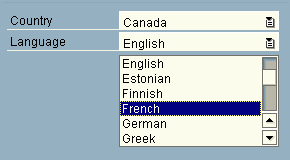Drop-Down List Boxes

Drop-down list boxes allow the user to choose an entry from a list, which drops down immediately below the field, and shows which values can be chosen. The drop-down list box is read-only, while the drop-down combo box allows the reader to make an entry in the main field, which is then added to the list if it is not already there. This type of drop-down combo box is not currently supported und is therefore not described in this context.
Display of Text versus Display of Codes
There are two possible types of content in drop-down list boxes: displays of text or displays of codes.
Usually, meaningful texts are displayed in the drop-down list box (for example, "Germany", and not just "D"). If an explanatory text relating to a code is available, then this is always displayed. The codes are then suppressed in the display, but passed to the application once a text has been selected.
However, it also sometimes makes sense only to put the codes into the drop-down list box. In this case, only the code selected is passed to the application.
Operation by the User
Although users cannot make direct entries directly in a drop-down list box, they can select possible entries using either the keyboard or the mouse. Only the first letter of each keyboard entry is evaluated, for example, typing an "E" scrolls down to the first entry beginning with "E"; if you then type another letter, the system scrolls down to the first entry beginning with this letter. Either a value is already preselected in the drop-down list box, or the drop-down list box displays an "empty" entry.
Use of Drop-Down List Boxes
The general use of drop-down list boxes instead of possible entries dialogue boxes is not recommended. Instead, drop-down list boxes should be used selectively where it is possible, for example, to support the selection of a value from a limited quantity more effectively than via possible entries in F4 help. Drop-down list boxes should replace the normal possible entries dialogue box in the following cases:
There are only a certain number of possible entries available (less than 40).
Selection from the drop-down list box menu is hindered by a scroll bar (due to a large number of entries) since, if you position the mouse incorrectly, an entry can be selected inadvertently, or the list can simply click shut without any value being selected. Therefore, scroll bars should only be used in exceptional cases, or avoided completely.
Sorting and limiting values etc. is not supported in drop-down list box menus, so the user is offered no help in managing a large number of values.
Using the drop-down list box must improve usability.
It is inadvisable to convert a field such as "currency key" into a drop-down list box, and to display the text instead. "Currency key" ("DEM", "USD") is a generally recognized code, which can be remembered and entered simply and quickly by the user, whereas the selection or entry of "American Dollars" (instead of "USD") or "Austrian Shillings" (instead of ATS) would be unusual here, and would not be so easily remembered by the user.
This is not the case for SAP-specific codes (company code, posting key, industry sector, material type, ...), which are learned in an SAP-specific context. In other words, they are not generally recognized.
The relationship between code and text must be clear.
Relationship between drop-down list boxes and other fields on the
screen
Due to accessibility requirements it is not allowed to change the
screen layout after selecting an item from a drop-down list box. Use screen
changes instead.
Exception: If a drop-down list box is related to an input field that is displayed immediately behind it, the related input field may be shown or hidden.
Source: SAP R/3 Style Guide